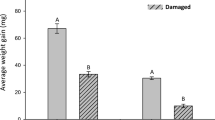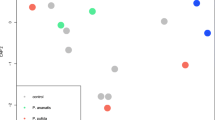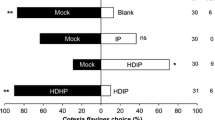Abstract
Attack by multiple herbivores often leads to modification of induced plant defenses compared to single herbivory, yet little is known about the effects on induced indirect plant defense. Here, we investigated the effect of sequential induction of plant defense by Mamestra brassicae caterpillar oral secretion and an infestation by Tetranychus urticae spider mites on the expression of indirect plant defense in Lima bean plants. The effect on indirect defense was assessed using behavior assays with the specialist predatory mite Phytoseiulus persimilis in an olfactometer, headspace analysis of 11 major herbivore-induced plant volatiles (HIPVs) including (E)-β-ocimene, and transcript levels of the corresponding gene Phaseolus lunatus (E)-β-ocimene synthase (PlOS). Predatory mites were found to distinguish between plants induced by spider mites and caterpillar oral secretion but not between plants with single spider mite infestation and plants induced by caterpillar oral secretion prior to spider mite infestation. Indeed, the volatile blends emitted by plants induced by spider mites only and the sequential induction treatment of caterpillar oral secretion followed by spider mite infestation, were similar. Our results suggest that plant indirect defense is not affected by previous treatment with oral secretion of M. brassicae caterpillars.




Similar content being viewed by others
References
Ament K, Kant MR, Sabelis MW, Haring MA, Schuurink RC (2004) Jasmonic acid is a key regulator of spider mite-induced volatile terpenoid and methyl salicylate emission in tomato. Plant Physiol 135:2025–2037
Arimura GI, Ozawa R, Shimoda T, Nishloka T, Boland W, Takabayashi J (2000) Herbivory-induced volatiles elicit defence genes in Lima bean leaves. Nature 406:512–515
Arimura GI, Köpke S, Kunert M, Volpe V, David A, Brand P, Dabrowska P, Maffei ME, Boland W (2008) Effects of feeding Spodoptera littoralis on Lima bean leaves: IV. Diurnal and nocturnal damage differentially initiate plant volatile emission. Plant Physiol 146:965–973
Brunissen L, Cherqui A, Pelletier Y, Vincent C, Giordanengo P (2009) Host-plant mediated interactions between two aphid species. Entomol Exp Appl 132:30–38
Conrath U (2009) Priming of induced plant defense responses. Adv Bot Res 51:361–395
De Boer JG, Dicke M (2004) The role of methyl salicylate in prey searching behavior of the predatory mite Phytoseiulus persimilis. J Chem Ecol 30:255–271
De Boer JG, Posthumus MA, Dicke M (2004) Identification of volatiles that are used in discrimination between plants infested with prey or nonprey herbivores by a predatory mite. J Chem Ecol 30:2215–2230
De Boer JG, Hordijk CA, Posthumus MA, Dicke M (2008) Prey and non-prey arthropods sharing a host plant: effects on induced volatile emission and predator attraction. J Chem Ecol 34:281–290
De Moraes CM, Lewis WJ, Paré PW, Alborn HT, Tumlinson JH (1998) Hervibore-infested plants selectively attract parasitoids. Nature 393:570–573
Delphia CM, Mescher MC, De Moraes CM (2007) Induction of plant volatiles by herbivores with different feeding habits and the effects of induced defenses on host-plant selection by thrips. J Chem Ecol 33:997–1012
Dicke M, Van Beek TA, Posthumus MA, Ben Dom N, Van Bokhoven H, De Groot A (1990) Isolation and identification of volatile kairomone that affects acarine predator–prey interactions Involvement of host plant in its production. J Chem Ecol 16:381–396
Dicke M, Gols R, Ludeking D, Posthumus MA (1999) Jasmonic acid and herbivory differentially induce carnivore-attracting plant volatiles in lima bean plants. J Chem Ecol 25:1907–1922
Dicke M, Van Loon JJA, Soler R (2009) Chemical complexity of volatiles from plants induced by multiple attack. Nature Chem Biol 5:317–324
Engelberth J, Viswanathan S, Engelberth MJ (2011) Low concentrations of salicylic acid stimulate insect elicitor responses in Zea mays seedlings. J Chem Ecol 37:263–266
Erb M, Foresti N, Turlings TCJ. 2010. A tritrophic signal that attracts parasitoids to host-damaged plants withstands disruption by non-host herbivores. BMC Plant Biol 10, art. no. 247.
Erb M, Robert CA, Hibbard BE, Turlings TC (2011) Sequence of arrival determines plant-mediated interactions between herbivores. J Ecol 99:7–15
Frost CJ, Mescher MC, Carlson JE, De Moraes CM (2008) Plant defense priming against herbivores: getting ready for a different battle. Plant Physiol 146:818–824
Kaplan I, Denno RF (2007) Interspecific interactions in phytophagous insects revisited: a quantitative assessment of competition theory. Ecology Lett 10:977–994
Kessler A, Baldwin IT (2002) Plant responses to insect herbivory: the emerging molecular analysis. Annu Rev Plant Biol 53:299–328
Kessler A, Baldwin IT (2004) Herbivore-induced plant vaccination. Part I. The orchestration of plant defenses in nature and their fitness consequences in the wild tobacco Nicotiana attenuata. Plant J 38:639–649
Koornneef A, Pieterse CMJ (2008) Cross talk in defense signaling. Plant Physiol 146:839–844
Kramer KJ, Muthukrishnan S (1997) Insect chitinases: molecular biology and potential use as biopesticides. Insect Biochem Molec Biol 27:887–900
Li C, Williams MM, Loh YT, Gyu IL, Howe GA (2002) Resistance of cultivated tomato to cell content-feeding herbivores is regulated by the octadecanoid-signaling pathway. Plant Physiol 130:494–503
Margis-Pinheiro M, Metz-Boutigue MH, Awade A, de Tapia M, le Ret M, Burkard G (1991) Isolation of a complementary DNA encoding the bean PR4 chitinase: an acidic enzyme with an amino-terminus cysteine-rich domain. Plant Mol Biol 17:243–253
Mathur V, Ganta S, Raaijmakers CE, Reddy AS, Vet LEM, Van Dam NM (2011) Temporal dynamics of herbivore-induced responses in Brassica juncea and their effect on generalist and specialist herbivores. Entomol Exp Appl 139:215–225
Mathur V, Tytgat TOG, de Graaf RM, Kalia V, Sankara Reddy A, Vet LEM, van Dam NM (2013) Dealing with double trouble: consequences of single and double herbivory in Brassica juncea. Chemoecology 23:71–82
McConn M, Creelman RA, Bell E, Mullet JE, Browse J (1997) Jasmonate is essential for insect defense in Arabidopsis. Proc Natl Acad Sci U S A 94:5473–5477
Menzel TR, Weldegergis BT, David A, Boland W, Gols, R, Van Loon, JJA, Dicke M. 2014. Synergism in the effect of prior jasmonic acid application on herbivore-induced volatile emission by Lima bean plants: transcription of a monoterpene synthase gene and volatile emission. J Exp Bot 65:4821–4831 doi:10.1093/jxb/eru242.
Mumm R, Dicke M (2010) Variation in natural plant products and the attraction of bodyguards involved in indirect plant defense. Canad J Zool 88:628–667
Ozawa R, Arimura GI, Takabayashi J, Shimoda T, Nishioka T (2000) Involvement of jasmonate- and salicylate-related signaling pathways for the production of specific herbivore-induced volatiles in plants. Plant Cell Physiol 41:391–398
Poelman EH, Broekgaarden C, Van Loon JJA, Dicke M (2008) Early season herbivore differentially affects plant defence responses to subsequently colonizing herbivores and their abundance in the field. Mol Ecol 17:3352–3365
Rodriguez-Saona C, Crafts-Brandner SJ, Cañas LA (2003) Volatile emissions triggered by multiple herbivore damage: beet armyworm and whitefly feeding on cotton plants. J Chem Ecol 29:2539–2550
Rodriguez-Saona CR, Musser RO, Vogel H, Hum-Musser SM, Thaler JS (2010) Molecular, biochemical, and organismal analyses of tomato plants simultaneously attacked by herbivores from two feeding guilds. J Chem Ecol 36:1043–1057
Schlumbaum A, Mauch F, Vögeli U, Boller T (1986) Plant chitinases are potent inhibitors of fungal growth. Nature 324:365–367
Schwartzberg EG, Böröczky K, Tumlinson JH (2011) Pea aphids, Acyrthosiphon Pisum, suppress induced plant iolatiles in broad bean, Vicia Faba. J Chem Ecol 37:1055–1062
Shiojiri K, Takabayashi J, Yano S, Takafuji A (2001) Infochemically mediated tritrophic interaction webs on cabbage plants. Pop Ecol 43:23–29
Stam JM, Kroes A, Li Y, Gols R, Van Loon JJA, Poelman EH, Dicke M (2014) Plant interactions with multiple insect herbivores: from community to genes. Annu Rev Plant Biol 65:689–713
Takabayashi J, Dicke M (1992) Response of predatory mites with different rearing histories to volatiles of uninfested plants. Entomol Exp Appl 64:187–193
Takabayashi J, Takahashi S, Dicke M, Posthumus MA (1995) Developmental stage of herbivore Pseudaletia separata affects production of herbivore-induced synomone by corn plants. J Chem Ecol 21:273–287
Van Poecke RMP, Dicke M (2002) Induced parasitoid attraction by Arabidopsis thaliana: involvement of the octadecanoid and the salicylic acid pathway. J Exp Bot 53:1793–1799
Viswanathan DV, Lifchits OA, Thaler JS (2007) Consequences of sequential attack for resistance to herbivores when plants have specific induced responses. Oikos 116:1389–1399
Voelckel C, Baldwin IT (2004) Herbivore-induced plant vaccination. Part II. Array-studies reveal the transience of herbivore-specific transcriptional imprints and a distinct imprint from stress combinations. Plant J 38:650–663
Zhang PJ, Zheng SJ, Van Loon JJA, Boland W, David A, Mumm R, Dicke M (2009) Whiteflies interfere with indirect plant defense against spider mites in Lima bean. Proc Natl Acad Sci U S A 106:21202–21207
Zhang PJ, Broekgaarden C, Zheng SJ, Snoeren TAL, Van Loon JJA, Gols R, Dicke M (2013) Jasmonate and ethylene signaling mediate whitefly-induced interference with indirect plant defense in Arabidopsis thaliana. New Phytol 197:1291–1299
Author information
Authors and Affiliations
Corresponding author
Electronic supplementary material
Below is the link to the electronic supplementary material.
ESM 1
(DOCX 214 kb)
Rights and permissions
About this article
Cite this article
Menzel, T.R., Huang, TY., Weldegergis, B.T. et al. Effect of Sequential Induction by Mamestra brassicae L. and Tetranychus urticae Koch on Lima Bean Plant Indirect Defense. J Chem Ecol 40, 977–985 (2014). https://doi.org/10.1007/s10886-014-0499-9
Received:
Revised:
Accepted:
Published:
Issue Date:
DOI: https://doi.org/10.1007/s10886-014-0499-9




